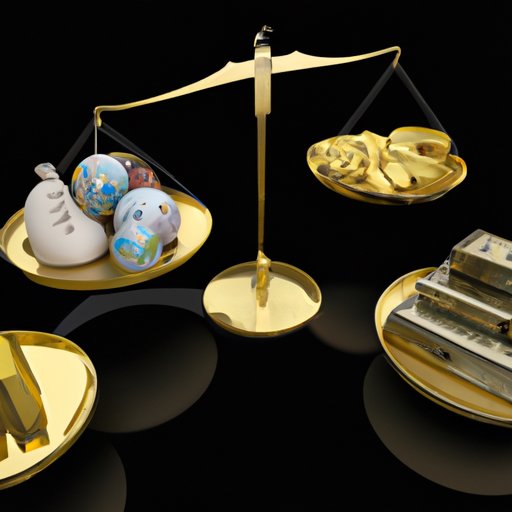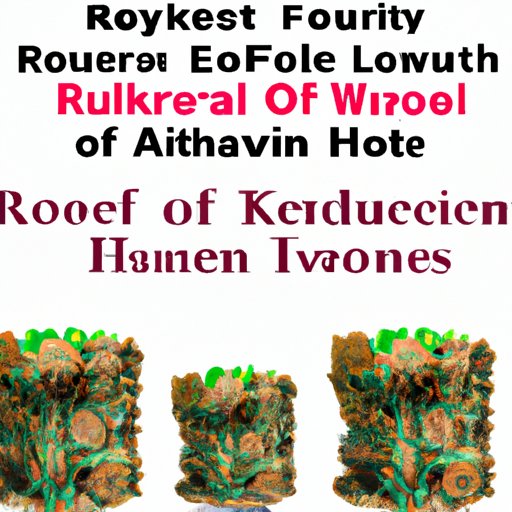
I. Introduction
Many people wonder about how much money is on Earth, but the answer to this question is not as simple as it seems. The amount of money available on Earth depends on various factors, including global wealth distribution, currency valuation, monetary reserves, and wealth disparities. In this article, we will explore each of these factors in detail to help readers understand the amount of money available on Earth and the factors that influence it.
II. The Global Wealth Distribution: How Much Money is on the Earth?
The global wealth distribution refers to the way in which wealth is distributed among individuals and countries around the world. According to recent reports, the top 1% of the world’s population owns roughly 44% of the world’s wealth, while the bottom 50% owns less than 2% of the world’s wealth.
Interesting facts about the amount of money available on Earth include:
- The total amount of global wealth is estimated to be around $360 trillion.
- The global financial assets are estimated to be around $294 trillion.
- The total amount of global debt is estimated to be around $277 trillion.
The major factors that influence global wealth distribution include income levels, education, geography, and political stability.
III. Understanding the Concept of Global GDP and its Association with Money on Earth
Gross Domestic Product (GDP) is a measure of the economic output of a country or region. It includes the value of all goods and services produced within a specific time period, usually a year. GDP is an important indicator of a country’s economic health and plays a significant role in determining the amount of money available on Earth.
According to the World Bank, the global GDP was around $87 trillion in 2019. When compared to the total amount of wealth in circulation, which is estimated to be around $360 trillion, it becomes evident that the amount of money available on Earth is significantly more than the global GDP.
However, using GDP as a measure of wealth distribution has some limitations. For instance, GDP does not take into account the distribution of wealth within a country or region. It only considers the total economic output, regardless of how it is distributed among the population.

IV. From Money Trees to Fort Knox: The Tale of Global Wealth Reserves
Countries store their monetary reserves in various ways, including in their central banks, foreign exchange reserves, sovereign wealth funds, and gold reserves. The amount of money stored in each location varies depending on the country’s economic conditions and its monetary policy.
For example, the United States stores a significant portion of its monetary reserves in Fort Knox, Kentucky, which is a highly secure facility that is guarded by the military. Other countries store their monetary reserves in their central banks or foreign exchange reserves, which are used to manage their currency exchange rates.
The benefits of storing wealth in different locations include diversification of risk, increased financial stability, and better currency management. However, there are also drawbacks, such as the potential for theft, lack of transparency, and limited access to funds in times of economic distress.
V. Comparing the Value of Different Currencies: Understanding the Total Amount of Money Available
Currency valuation refers to the process of determining the value of one country’s currency relative to another country’s currency. It plays a significant role in determining the total amount of money available on Earth.
The value of different currencies is determined by various factors, including interest rates, inflation rates, economic growth, political stability, and global demand. For example, the U.S. dollar is considered a strong currency because it is widely accepted around the world and is the currency of choice for international trade and finance.
The role of currency exchange markets is to facilitate the exchange of different currencies so that businesses and individuals can conduct international transactions. The size and liquidity of currency exchange markets influence the value of different currencies and the amount of money available on Earth.
VI. Exposing the Wealth Disparities: Billionaires and Poverty
Wealth disparities refer to the unequal distribution of wealth within a population or region. Wealth disparities can occur across countries or within a single country. They can have a significant impact on the amount of money available on Earth.
The world’s billionaires collectively own approximately $11.4 trillion, which is more than the GDP of many countries. On the other hand, poverty continues to be a significant problem around the world. As of 2020, around 9% of the global population lived in extreme poverty, which is defined as living on less than $1.90 per day.
The impact of billionaires and poverty on global wealth distribution can be significant. For instance, if the world’s billionaires were to lose half of their wealth, it could provide enough funding to end extreme poverty around the world.
VII. Precious Metals and Their Contribution to World Money
Precious metals such as gold, silver, and platinum have been used as stores of value and mediums of exchange for centuries. They play a significant role in the global economy and influence the amount of money available on Earth.
Precious metals are often used as a hedge against inflation and political instability. For example, during times of economic uncertainty, investors may choose to invest in gold as a safe-haven asset. Similarly, central banks hold gold as a part of their monetary reserves to manage their currency exchange rates.
However, relying on precious metals as a store of value has some limitations. For instance, the value of precious metals can fluctuate significantly over time, making it challenging to determine their true value. Additionally, the availability of precious metals is limited, which can pose challenges for countries that rely on gold as a currency reserve.
VIII. Wrapping up the Global Wealth Report: Key Takeaways About the Money on Earth
Recent reports on global wealth distribution provide some valuable insights into the amount of money available on Earth. Some of the key findings include:
- The top 1% of the world’s population owns around 44% of the world’s wealth.
- The total amount of global wealth is estimated to be around $360 trillion.
- The global GDP was around $87 trillion in 2019.
- Currency exchange markets play a significant role in determining the amount of money available on Earth.
- Wealth disparities and billionaires continue to be significant challenges for global wealth distribution.
The projected growth rate for global wealth in the coming years is expected to be around 5%-6% per year, with the bulk of the growth occurring in the Asia-Pacific region.
IX. Conclusion
In conclusion, understanding the amount of money available on Earth requires an analysis of global wealth distribution, GDP, monetary reserves, currency valuation, wealth disparities, and precious metals. The factors that influence global wealth distribution are complex and multi-faceted, but understanding them is critical to developing effective policies that can help reduce global inequality.
For readers who want to learn more about the topic, additional resources include recent reports on global wealth distribution, academic studies on wealth disparities, and books on the history of money and the global economy.





